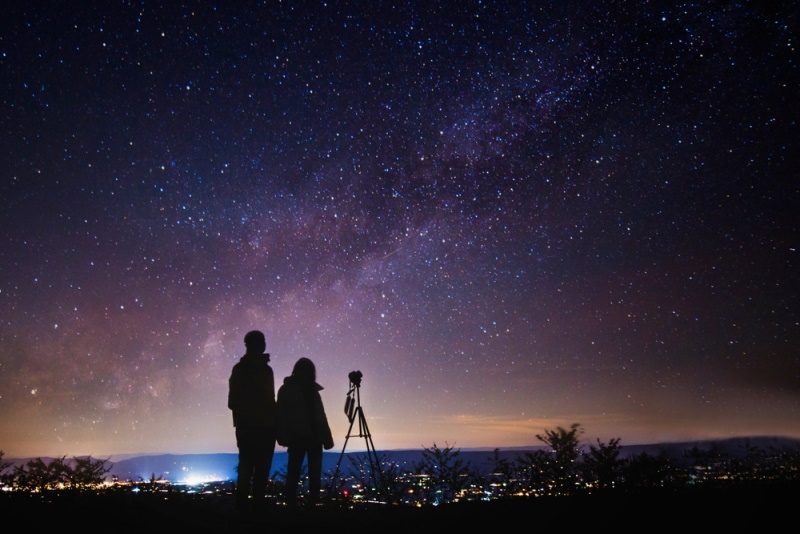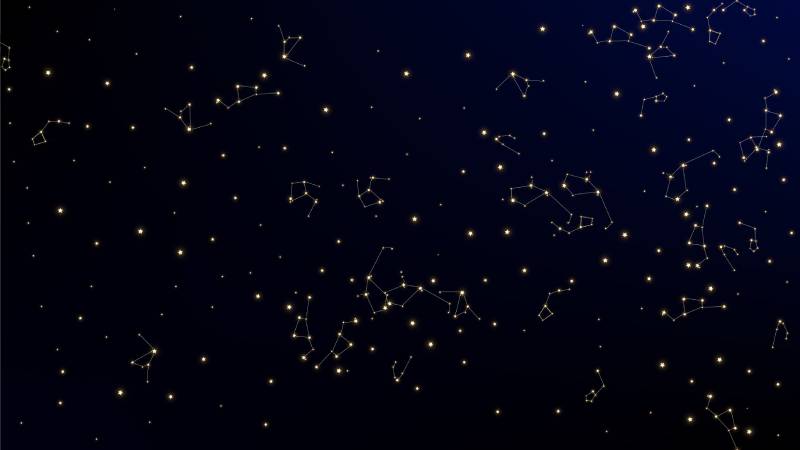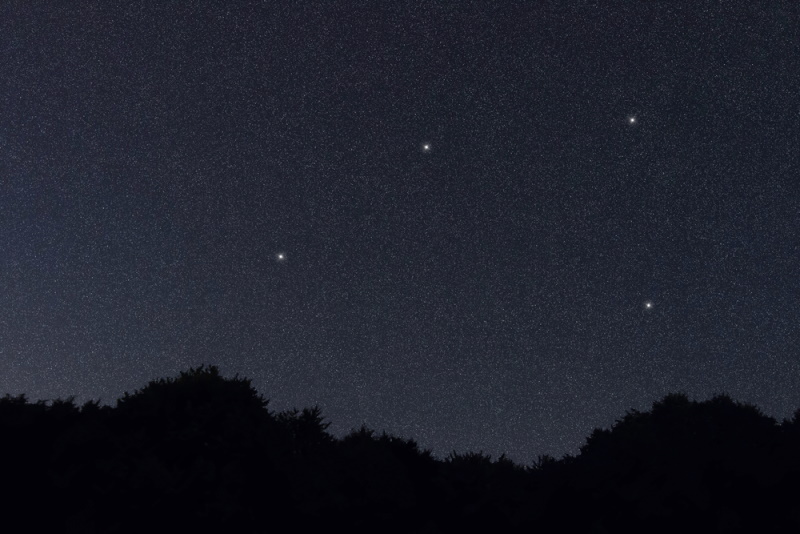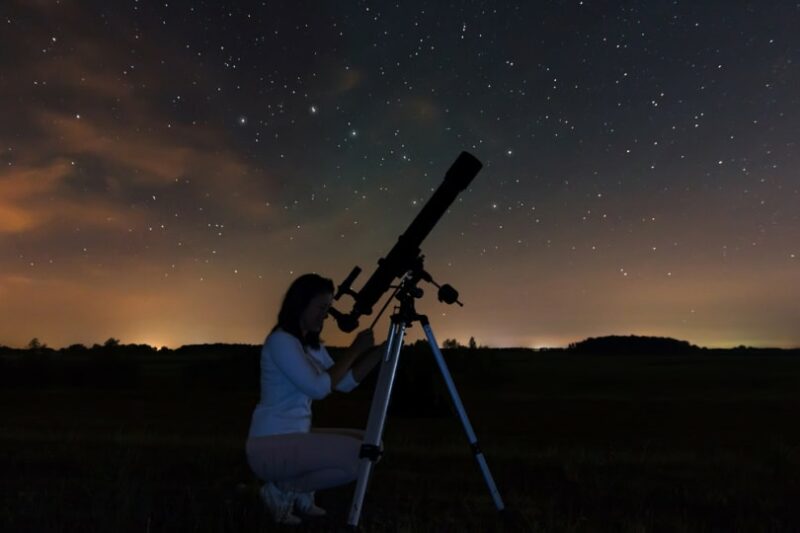How Many Constellations Are There? What to Know!
Last Updated on

The International Astronomical Union (IAU) recognizes 88 constellations to date. The IAU listed down these modern constellations in 1922.1 However, their boundaries were determined later in 1928 by Eugène Delporte, a Belgian astronomer.
Every constellation is denoted with an abbreviation devised by American astronomer Henry Norris Russell. The IAU approved his list of abbreviations in May 1922. Russell’s constellation list complemented the one in the Revised Harvard Photometry star catalog, published in 1908.
The constellations are primarily divided based on their location in the sky. The Northern Celestial Hemisphere constitutes about 36 constellations, and the Southern Hemisphere has around 52.
Let’s learn more about constellations and their abbreviations and whether you can see them in the night sky.

What Are Constellations?
A constellation is a star cluster arranged in a specific shape in the sky. Every constellation has a different name, shape, and type of star. These stars lie far from the Earth, so you’re less likely to see them with the naked eye.
Stars in a constellation don’t connect with each other. Some live close by, while others are present at enormous distances. If you take a pen and draw dot-to-dot lines between these stars, you’ll see that they look like a person, animal, or object. Over centuries, many mythologies and cultures have given different names and shapes to the constellations.
Today, we have 88 IAU-recognized constellations. Fifteen resemble some sort of animal, such as a wolf and bull, and eight look like birds, including a peacock and toucan. Finally, nine are water-based constellations featuring a dolphin, sea monster, and crab.
Twenty-eight constellations appear to be some kind of object, including a cross, harp, clock, compass, and microscope. The rest can look like anything, from mythical creatures to insects and flies.

A Brief History of Constellations in Greek Mythology
All 88 constellations come from different backgrounds and origins. However, most of them depend on the constellations mentioned in the 2nd century CE astronomical treatise called “The Almagest.”
A Greek astronomer of Alexandria, Claudius Ptolemy, cataloged 48 ancient constellations in “The Almagest.” Different figures, gods, or rulers from Greek mythology represent these constellations. Some of them include:
- Andromeda
- Cassiopeia
- Canis Major
- Canis Minor
- Eridanus
- Hercules
- Orion
- Perseus
- Pegasus
- Ursa Major
- Ursa Minor
These ancient constellations also include 12 zodiac constellations.
Ptolemy only discovered these constellations; he didn’t build them. These were already popular to observers long before Ptolemy identified them. So, although they are Greek constellations, the Greeks didn’t actually create them.
The creators of these constellations are unknown, but they may date back to prehistoric periods.

Greek Constellations
Fifty out of 88 constellations are Greek ones. One of Ptolemy’s constellations, Argo Navis, used to be the largest constellation in the sky, but it’s not in use today. It looked like Jason’s ship and the Argonauts.
In the 18th century, French astronomer Nicolas-Louis de Lacaille divided Argo Navis into three smaller constellations: Vela, Carina, and Puppis. These constellations then stayed in use.
The Greeks consider Coma Berenices (Berenice’s Hair) an asterism, but it was not on Ptolemy’s constellations list.
Later, a German cartographer, Caspar Vopel, designated Coma Berenices as a separate constellation. Soon after, Tycho Brahe, a Danish astronomer, listed the constellation in the 1602’s star catalog.
Dutch Constellations
The remaining constellations were invisible to Greek astronomers as they were located in the southern hemisphere. However, these got recognized in and after the Age of Discovery.
In 1595, two Dutch explorers, Frederick de Houtman and Pieter Dirkszoon Keyser, created 12 constellations. At that time, they were en route to Indonesia and got the chance to observe the southern sky.
Frederick and Pieter named most of the constellations after animals they saw in the South. A few of these include:
- Apus (Bird of Paradise)
- Chamaeleon
- Dorado (the Dolphinfish)
- Grus (the Crane)
- Musca (the Fly)
- Tucana (the Toucan)
- Volans (the Flying Fish)

The Dutch constellations became recognized in 1597/1598 with the efforts of a Dutch-Flemish astronomer named Petrus Plancius. He depicted these constellations on his 35-m celestial globe.
Plancius trained Pieter Dirkszoon Keyser to observe the stars in the Southern sky. Unfortunately, Keyser died during this discovery, but he managed to deliver his and Houtman’s star catalog to Plancius.
With information on hand, Plancius depicted many constellations of the Southern hemisphere. These include Triangulum Australe and Crux. In 1562, he displayed Columba (the Dove) on his globe’s small planispheres.
Later in 1612 or 1613, Plancius depicted eight constellations on another celestial globe. Today, only two are in use: Camelopardalis (the Giraffe) and Monoceros (the Unicorn). A few of the obsolete ones include:
- Apes (the Bee)
- Cancer Minor (the Small Crab)
- Gallus (the Rooster)
- Sagitta Australis (the Southern Arrow)
All the Plancius’ constellations became famous when they appeared in Uranometria, written by a German astronomer Johann Bayer. It was the first atlas that covered stars in the entire sky, published in Augsburg in 1603.
Polish Constellations
In the 17th century, a Polish astronomer, Johannes Hevelius, added 10 new constellations. Out of these, seven are still in use, including:
- Canes Venatici (the Hunting Dogs)
- Lacerta (the Lizard)
- Leo Minor (the Smaller Lion)
- Lynx
- Scutum (the Shield)
- Sextans
- Vulpecula (the Fox)

The obsolete ones are:
- Cerberus
- Mons Maenalus (Mount Maenalus)
- Triangulum Minus (the Smaller Triangle)
He depicted all these constellations in his 1687 atlas titled “Firmamentum Sobiescianum sive Uranographia.”
French Constellations
Nicolas-Louis de Lacaille added 14 more constellations to the Southern hemisphere. He based his observations on South Africa’s Cape of Good Hope. These constellations are small and invisible if you observe them from mid-northern latitudes.
Lacaille named most of these constellations after scientific tools, such as:
- Antlia (the Air Pump)
- Caelum (the Chisel)
- Fornax (the Furnace)
- Horologium (the Pendulum Clock)
- Microscopium (the Microscope)
- Octans (the Octant)
- Pyxis (the Compass)
- Telescopium (the Telescope)
All 14 French constellations are still in use.

The IAU List of 88 Modern Constellations
Here is the list of all 88 modern constellations we talked about above:
| Andromeda | Circinus | Lacerta | Piscis Austrinus |
| Antlia | Columba | Leo | Puppis |
| Apus | Coma Berenices | Leo Minor | Pyxis |
| Aquarius | Corona Australis | Lepus | Reticulum |
| Aquila | Corona Borealis | Libra | Sagitta |
| Ara | Corvus | Lupus | Sagittarius |
| Aries | Crater | Lynx | Scorpius |
| Auriga | Crux | Lyra | Sculptor |
| Boötes | Cygnus | Mensa | Scutum |
| Caelum | Delphinus | Microscopium | Serpens |
| Camelopardalis | Dorado | Monoceros | Sextans |
| Cancer | Draco | Musca | Taurus |
| Canes Venatici | Equuleus | Norma | Telescopium |
| Canis Major | Eridanus | Octans | Triangulum |
| Canis Minor | Fornax | Ophiuchus | Triangulum Australe |
| Capricornus | Gemini | Orion | Tucana |
| Carina | Grus | Pavo | Ursa Major |
| Cassiopeia | Hercules | Pegasus | Ursa Minor |
| Centaurus | Horologium | Perseus | Vela |
| Cepheus | Hydra | Phoenix | Virgo |
| Cetus | Hydrus | Pictor | Volans |
| Chamaeleon | Indus | Pisces | Vulpecula |
Can You See Constellations in the Night Sky?
You can see constellations in the night sky. However, the type of constellations you can see varies depending on the time of the year.
As we all know, Earth completes its orbit around the Sun yearly. This keeps changing our view of the sky and space. Thus, the night sky looks different every night because our motherland continuously changes its spot in orbit. Similarly, the stars seem a little toward the West from where they were the previous night.
One important thing to note is that your location on the Earth also significantly determines what constellations you can see. The Earth’s Northern hemisphere is pointed towards the opposite of the Southern Hemisphere.
Therefore, Australians and Americans can’t see the same constellations simultaneously.
For example, you’re in the Northern Hemisphere and can see the Pisces constellation. Your friend living in the Southern hemisphere can’t see Pisces because Virgo is visible on their side of the Sun.


Final Thoughts
The International Astronomical Union (IAU) has recognized 88 modern constellations. Astronomers from different backgrounds, including Greek, Polish, French, and Dutch, contributed to discovering these constellations.
No astronomer created the constellations. Instead, these star clusters were already there, waiting to be discovered.
Over the years, people from different cultures associated constellations with distinctive meanings. Most of them are of Greek origin, named after objects, humans, animals, and birds. Twelve belong to the zodiac signs.
Featured Image Credit: Marti Bug Catcher, Shutterstock
About the Author Jeff Weishaupt
Jeff is a tech professional by day, writer, and amateur photographer by night. He's had the privilege of leading software teams for startups to the Fortune 100 over the past two decades. He currently works in the data privacy space. Jeff's amateur photography interests started in 2008 when he got his first DSLR camera, the Canon Rebel. Since then, he's taken tens of thousands of photos. His favorite handheld camera these days is his Google Pixel 6 XL. He loves taking photos of nature and his kids. In 2016, he bought his first drone, the Mavic Pro. Taking photos from the air is an amazing perspective, and he loves to take his drone while traveling.
Related Articles:
15 Crucial Facts About Ultraviolet Rays & the Sun
What Constellation Is Spica In? The Interesting Answer!
10 Interesting Leo Constellation Facts, Myths, and FAQs
15 Interesting Pegasus Constellation Facts, Myths, and FAQs
6 Interesting Sagittarius Constellation Facts, Myths, and FAQs in 2024!
What Are Constellations? Where Did They Come From?
8 Interesting Libra Constellation Facts, Myths, and FAQs
What Is Infrared Radiation? Science-Based Facts & FAQ
